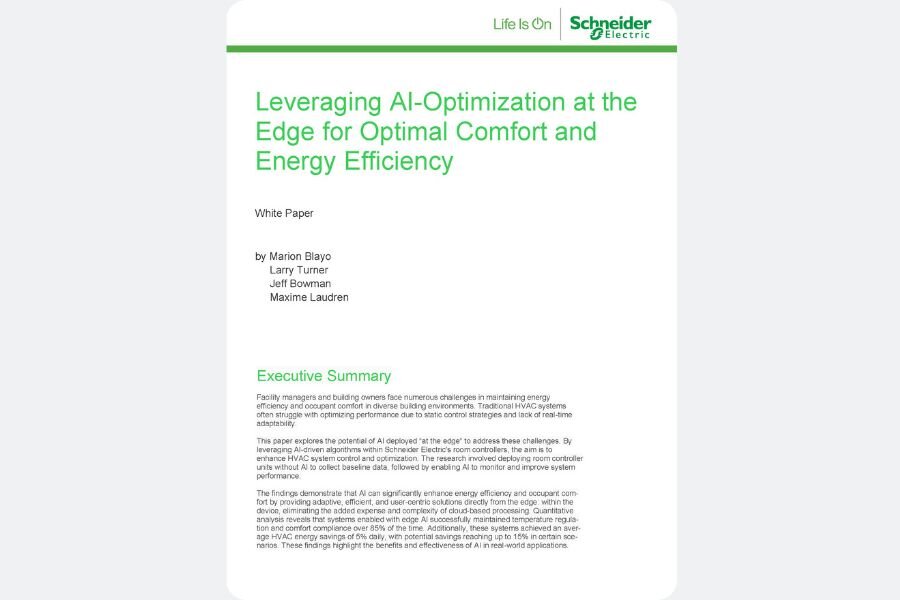How AI at the Edge is Transforming HVAC Systems
- By Marion Blayo, Larry Turner, Jeff Bowman, & Maxime Laudren
- 15 Oct 2025
- 4 min read
Energy use and maintaining occupant comfort have always been critical areas of focus for buildings managers, whether they are large corporate offices or smaller facilities. With rising energy costs and increasing awareness of environmental concerns, the importance of finding cost-efficient and effective solutions is greater than ever.
Unfortunately, many traditional HVAC systems are designed around static control models that cannot respond dynamically to real-time conditions. This often leads to wasted energy and inconsistent comfort levels, creating challenges for building operators and occupants alike.
Field trials show that a next-generation approach, incorporating artificial intelligence (AI) directly into HVAC room controllers, can significantly improve adaptability, control accuracy, and operational costs.
The addition of AI to HVAC systems provides benefits that extend far beyond traditional solutions. The most significant improvement lies in the capability for real-time, adaptive control that happens directly within the device itself.
This eliminates the need for a constant connection to remote servers or cloud-based computing systems and reduces response times to as little as one to two seconds. Such immediate adjustments are critical for maintaining a consistent level of comfort for occupants, especially in situations where even minor delays can cause temperature instability.
Additionally, by limiting reliance on external networks, the system provides consistent performance even in areas where connectivity may be intermittent or unreliable.
This localized data processing also reduces the amount of information that needs to be sent to centralized building management systems, lowering bandwidth usage and making the entire operation more efficient.
With AI-based HVAC optimization algorithm, the system continuously learns and adapts by analyzing data such as occupancy levels, previous temperature trends, and external weather conditions. By leveraging these insights, adjustments are made dynamically to optimize both energy consumption and indoor comfort levels.
Compared to traditional setups that rely heavily on cloud computing resources, edge-based AI solutions have significantly lower infrastructure requirements, which translates to reduced operational costs without compromising system performance or user experience.
AI-powered HVAC in educational buildings: A net digital impact use case

Our Dynamic HVAC Optimization algorithm applied in room controllers has been tested in real-world environments, in a variety of settings, ranging from office spaces and meeting rooms to storage areas and server facilities, to assess its effectiveness in managing both comfort and energy use.
During the initial week of implementation, the system achieved a temperature compliance rate of more than 75%, and this figure increased to over 82% by the second week as the algorithm adapted to the specific conditions of each site.
Moreover, in seven days of active operation during occupied hours, the algorithm was able to establish optimal start and stop times for each zone, reflecting its ability to adapt rapidly to different environments.
This rapid improvement showcases the algorithm’s ability to learn and optimize quickly, even when deployed in diverse building environments.
Energy savings have been noteworthy. In one trial where advanced metering was in place, electricity consumption was reduced by an average of nearly 5% per day during the testing period, with some days achieving reductions as high as 15%.
These savings are achieved through dynamic adjustments to setpoints, informed by real-time data on factors like occupancy patterns, outside temperatures, and the thermal properties of the building. This smart adjustment capability ensures that energy is used efficiently while maintaining comfortable indoor conditions.
Feedback from occupants during these trials has been overwhelmingly positive, with thermal comfort levels meeting or exceeding expectations. Surveys conducted after the trials indicated that most users felt the indoor climate was either at or very close to their preferred level, with minimal fluctuations observed. This combination of technical success and user satisfaction highlights the broad potential of these systems to transform building management.
The Dynamic HVAC Optimization algorithm follows a clear and structured process that ensures both accuracy and adaptability.
Measure
Sensors integrated into the room controller collect data to monitor temperature, humidity, and other relevant parameters.
Assess
Internal models evaluate this data to assess the current conditions and determine any necessary adjustments.
Predict
The system forecasts optimal temperature adjustments based on environmental and zone-specific conditions.
Control
Changes are made to temperature setpoints dynamically, with ongoing monitoring to adjust and ensure compliance with established standards.
Learn
The system refines its predictive models over time, continuously improving its performance as more data is collected.
This structured, iterative process enables the algorithm to continually evolve, making it better equipped to handle changes in building usage patterns, seasonal variations, and other environmental factors over time.
As smart technologies continue to evolve, the role of AI in optimizing building systems will only grow in importance. Cloud, as well as edge-based AI solutions like the Dynamic HVAC Optimization algorithm, represent a significant step forward in creating intelligent systems that prioritize both efficiency and user experience. By focusing on local data processing and adaptive control, these technologies offer benefits that are both immediate and long-lasting, from cost savings to improved indoor environments.
Moving forward, the adoption of these systems is likely to accelerate as building operators recognize their ability to deliver consistent performance and measurable results. With a focus on practical applications and user-centric design, these innovations will redefine how buildings are managed, ensuring they remain functional, comfortable and sustainable, for the years to come – a critical asset on the road to net zero, as buildings contribute to 37% of global carbon emissions and 80% of existing buildings in cities will remain in 2050.
Download the full Schneider Electric white paper “Leveraging AI-Optimization at the Edge for Optimal Comfort and Energy Efficiency” by Marion Blayo, AI/ML Lead Engineer, Larry Turner, Principal Data Scientist, Jeff Bowman, Software Architect and Research Lead and Maxime Laudren, Global Expert Technical Support.

Latest in Digitalization
How AI at the edge is transforming HVAC systems for efficiency and comfort
Reinventing cities: Driving urban resilience with digital innovation
Maximizing building efficiency with advanced wireless IoT sensors
The rise of smarter homes: harnessing AI for energy efficiency and resilience



